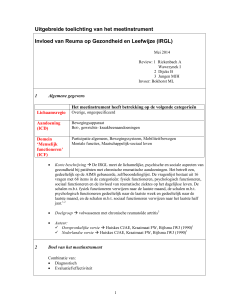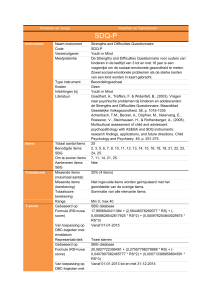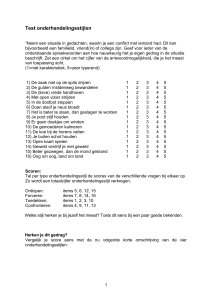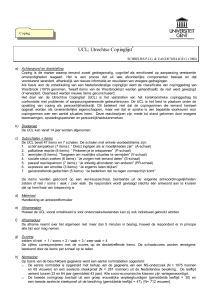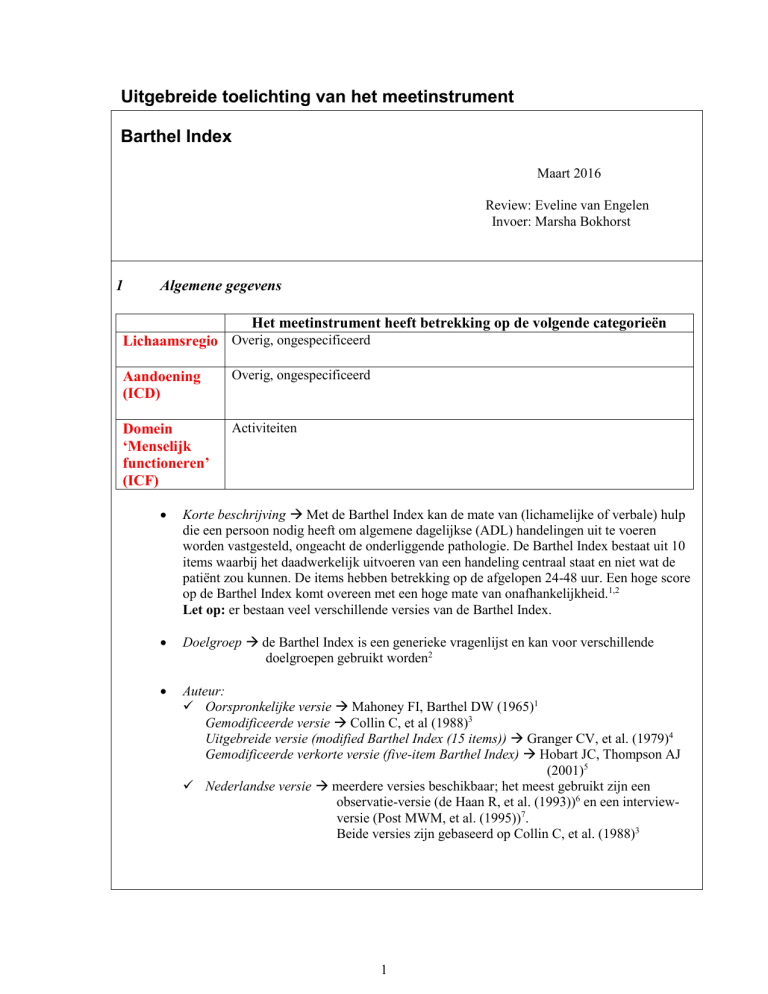
Uitgebreide toelichting van het meetinstrument
Barthel Index
Maart 2016
Review: Eveline van Engelen
Invoer: Marsha Bokhorst
1
Algemene gegevens
Het meetinstrument heeft betrekking op de volgende categorieën
Lichaamsregio Overig, ongespecificeerd
Aandoening
(ICD)
Overig, ongespecificeerd
Domein
‘Menselijk
functioneren’
(ICF)
Activiteiten
Korte beschrijving Met de Barthel Index kan de mate van (lichamelijke of verbale) hulp
die een persoon nodig heeft om algemene dagelijkse (ADL) handelingen uit te voeren
worden vastgesteld, ongeacht de onderliggende pathologie. De Barthel Index bestaat uit 10
items waarbij het daadwerkelijk uitvoeren van een handeling centraal staat en niet wat de
patiënt zou kunnen. De items hebben betrekking op de afgelopen 24-48 uur. Een hoge score
op de Barthel Index komt overeen met een hoge mate van onafhankelijkheid.1,2
Let op: er bestaan veel verschillende versies van de Barthel Index.
Doelgroep de Barthel Index is een generieke vragenlijst en kan voor verschillende
doelgroepen gebruikt worden2
Auteur:
Oorspronkelijke versie Mahoney FI, Barthel DW (1965)1
Gemodificeerde versie Collin C, et al (1988)3
Uitgebreide versie (modified Barthel Index (15 items)) Granger CV, et al. (1979)4
Gemodificeerde verkorte versie (five-item Barthel Index) Hobart JC, Thompson AJ
(2001)5
Nederlandse versie meerdere versies beschikbaar; het meest gebruikt zijn een
observatie-versie (de Haan R, et al. (1993))6 en een interviewversie (Post MWM, et al. (1995))7.
Beide versies zijn gebaseerd op Collin C, et al. (1988)3
1
2
Doel van het meetinstrument
3
Evaluatief / effectiviteit
Soort / vorm van het meetinstrument
Vragenlijst
Observatielijst (indien de items uitgevoerd worden)
Opbouw totaal 10 items
totaal 15 items; subcategorieën: zelfzorg (9 items), mobiliteit (6 items)
Invulinstructie gesloten vragen in te vullen door patiënt of observator
Versie met 10 items van Collin3:
Meetniveau per item: wijze score (0 tot 1,2,3); meetniveau ordinaal
Meetniveau totaalscore: wijze score (0-20); meetniveau ordinaal
Versie met 15 items van Granger4:
Meetniveau per item: wijze score (-2 tot 15); meetniveau ordinaal
Meetniveau per subtest: zelfzorg index: wijze score (-2 tot 53); meetniveau ordinaal
per subtest: mobiliteitsindex: wijze score (0 tot 47); meetniveau ordinaal
Meetniveau totaalscore: wijze score (0-100); meetniveau ordinaal
Versie met 5 items van Hobart5:
Meetniveau per item: wijze score (0 tot 1, 2, 3); meetniveau ordinaal
Meetniveau totaalscore: wijze van score (0-11); meetniveau ordinaal
4
Verkrijgbaarheid
5
Opvraagbaar bij www.meetinstrumentenzorg.nl
Geschatte kosten gratis te downloaden
Copyright ja, voor commerciële doeleinden dient toestemming gevraagd te worden aan
Maryland State Medical Society8
Methodologische kwaliteit
Gegevens over de methodologische kwaliteit zijn terug te vinden in de volgende reviews:
Barthel Index:
- Dawson J, Shamley D, Jamous MA. A structured review of outcome measures used for the
assessment of rehabilitation interventions for spinal cord injury. 2008
- Deathe AB, Wolfe DL, Devlin M, Hebert JS, Miller WC, Pallaveshi L. Selection of outcome
measures in lower extremity amputation rehabilitation: ICF activities. 2009
- Harrison JK, McArthur KS, Quinn TJ. Assessment scales in stroke: clinimetric and clinical
considerations. 2013
- Balu S. Differences in psychometric properties, cut-off scores, and outcomes between the
Barthel Index and Modified Rankin Scale in pharmacotherapy-based stroke trials: systematic
literature review. 2009
2
Gemodificeerde Barthel Index:
- Furlan JC, Noonan V, Singh A, Fehlings MG. Assessment of disability in patients with acute
traumatic spinal cord injury: a systematic review of the literature. 2011
6
Hanteerbaarheid / feasibility
7
Taal origineel Engels1, vertaling Nederlands3
Benodigdheden invulformulier
Randvoorwaarden
Benodigde tijd vragenlijst: 2-5 minuten14; observatielijst: 45-60 minuten15
Gebruikershandleiding nee
Normgegevens
Uitkomstklassen en normgegevens
Versie met 10 items7:
Interpretatie: 20 : volledig zelfstandig in basale ADL en mobiliteit;
15-19: redelijk tot goed zelfstandig;
10-14: heeft wel hulp nodig maar doet ook veel zelf;
5-9 : ernstig hulpbehoevend;
0-4 : volledig hulpbehoevend
Versie met 15 items16:
Interpretatie: Score > 60: overplaatsing naar de thuissituatie is mogelijk, indien
de patiënt minimaal twee uur per dag geholpen wordt
met ADL-activiteiten;
Score > 80: patiënt kan overgeplaatst worden naar de thuissituatie,
maar heeft twee uur of minder per dag hulp nodig bij de
zelfverzorging
8
Overige gegevens
De Barthel Index is vooral geschikt voor gebruik als het gaat om mensen met ernstige
functiebeperkingen. Bij diverse onderzoeken is een ceiling effect waargenomen.17
Er zijn verschillende prognostische modellen ontwikkeld. De meting vindt 1 á 2 weken na de
CVA plaats en doet een voorspelling over het niveau van ADL-functioneren een paar
maanden later. De opgenomen formules zijn oplopend in complexiteit:
1) BI [initieel week 1] + 8 = BI [12 weken na CVA]
2) 8,458 + (0,505*BI [initieel week 2]) + (4,185*SB) + (2,069*SS) = BI [6 maanden na
CVA]
SB: sitting balance; SB krijgt een score ‘1’ als de patiënt in staat is om 30 sec
ongesteund te zitten, ‘0’ als niet.
SS: social support; SS krijgt een score ‘1’ als de patiënt thuisondersteuning krijgt van
een familielid, ‘0’ als niet.18
De Barthel Index kan tevens middels een interviewversie worden afgenomen.19
3
9
Literatuurlijst
1. Mahoney FI, Barthel DW. Functional evaluation: the Barthel Index. Maryland state medical
journal. 1965 Feb;14:61-65.
2. Koolstra M, Smeets CJ, Harmeling-van der Wel BC, Kwakkel G. Klinimetrie na een beroerte:
een praktische handleiding. Amersfoort: Nederlands Paramedisch instituut; 2004.
3. Collin C, Wade DT, Davies S, Horne V. The Barthel ADL Index: a reliability study.
International disability studies. 1988;10(2):61-63.
4. Granger CV, Albrecht GL, Hamilton BB. Outcome of comprehensive medical rehabilitation:
measurement by PULSES profile and the Barthel Index. Archives of physical medicine and
rehabilitation. 1979 Apr;60(4):145-154.
5. Hobart JC, Thompson AJ. The five item Barthel index. Journal of neurology, neurosurgery and
psychiatry. 2001 Aug;71(2):225-230.
6. de Haan R, Limburg M, Schuling J, Broeshart J, Jonkers L, van Zuylen P. Klinimetrische
evaluatie van de Barthel Index: een maat voor beperkingen in het dagelijks functioneren.
Nederlands tijdschrift voor geneeskunde. 1993;137(18):917-21.
7. Post MWM, van Asbeck FW, van Dijk AJ, Schrijvers AJ. Nederlandse interview versie van de
Barthel index onderzocht bij dwarslaesiepatiënten. Nederlands tijdschrift voor geneeskunde.
1995;139(27):1376-1380.
8. Douglas G, Carroll MD. Functional evaluation: the Barthel Index. Maryland state medical
journal. 1965 Feb;14:56-61.
9. Dawson J, Shamley D, Jamous MA. A structured review of outcome measures used for the
assessment of rehabilitation interventions for spinal cord injury. Spinal cord. 2008
Dec;46(12):768-780.
10. Deathe AB, Wolfe DL, Devlin M, Hebert JS, Miller WC, Pallaveshi L. Selection of outcome
measures in lower extremity amputation rehabilitation: ICF activities. Disability and
rehabilitation. 2009;31(18):1455-1473.
11. Harrison JK, McArthur KS, Quinn TJ. Assessment scales in stroke: clinimetric and clinical
considerations. Clinical interventions in aging. 2013;8:201-211.
12. Balu S. Differences in psychometric properties, cut-off scores, and outcomes between the
Barthel Index and Modified Rankin Scale in pharmacotherapy-based stroke trials: systematic
literature review. Current medical research and opinion. 2009 Jun;25(6):1329-1341.
13. Furlan JC, Noonan V, Singh A, Fehlings MG. Assessment of disability in patients with acute
traumatic spinal cord injury: a systematic review of the literature. Journal of neurotrauma. 2011
Aug;28(8):1413-1430.
14. Roy CW, Togneri J, Hay E, Pentland B. An inter-rater reliability study of the Barthel Index.
International journal of rehabilitation research. 1988 Mar;11(1):67-70.
15. Ranhoff AH, Laake K. The Barthel ADL index: scoring by the physician from patient interview
is not reliable. Age and ageing. 1993 May;22(3):171-174.
16. MacKnight C, Bottomly JM. Geriatrie in de fysiotherapeutische praktijk. Houten: Bohn Stafleu
Van Loghum; 1999. p. 153-187.
17. Sarker SJ, Rudd AG, Douiri A, Wolfe CD. Comparison of 2 extended activities of daily living
scales with the Barthel Index and predictors of their outcomes: cohort study within the South
London Stroke Register (SLSR). Stroke. 2012 May;43(5):1362-1369.
18. van Peppen R, Beurskens S. Voorspellen van ADL-zelfstandigheid bij patiënten met een CVA:
de Barthel Index. Fysiopraxis. 2010 Jun;18-20.
19. Post MWM, van Asbeck FWA, van Dijk AJ, Schrijvers AJP. Nederlandse interviewversie van
de Barthel-index onderzocht bij dwarslaesiepatiënten. Nederlands tijdschrift voor geneeskunde.
1995 Jul 8;139(27):1376-1380.
4



